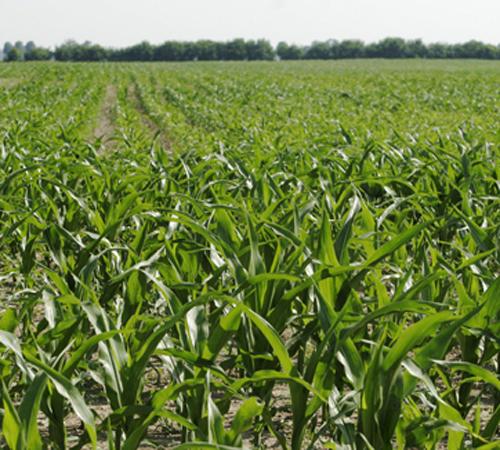Ethanol growing source of alternative fuel in Illinois, U.S.

This June 13, 2007, photo shows corn being grown to produce ethanol, in a field in London, Ohio. Because of the rising demand for ethanol, farmers are growing more corn. Kiichiro Sato, The Associated Press
July 26, 2007
With gasoline prices continuing to skyrocket, scientists have been looking to natural substances to solve America’s fuel needs.
The major crop that has been used is corn, which can be converted to ethanol to power motor vehicles. Ethanol is combined with gasoline to produce a fuel that pollutes the air less and is easier on car engines. According to the Federal Ministry for Food, Agriculture and Consumer Protection, the United States and Brazil are currently the largest producers of ethanol in the world.
“People like it because it’s made here in the U.S. and it’s made from Illinois corn,” said Mark Lambert, Communications Director for the Illinois Corn Growers Association.
Leif Wildman, senior in ACES and intern with the Illinois Corn Growers Association, said that there are two types of ethanol fuel that are currently being used – E10 and E85.
“The difference between E10 and E85 is the amount of gasoline that is mixed with it,” Wildman said.
Get The Daily Illini in your inbox!
E10 has 10 percent alcohol and 90 percent gasoline, while E85 has 85 percent ethanol and 15 percent gasoline, Wildman said.
Ethanol is produced primarily in the Midwest. Lambert said several gas stations throughout the state, particularly in Springfield and Bloomington, have been using E85 ethanol in their area for the last few years. However, areas such as Peoria and Champaign have only recently begun converting fuel pumps to ethanol.
The Mobil gas station at the corner of First and Green streets is currently in the process of adding E85 pumps to its station.
Sales have been very strong in areas where E85 has been used, Lambert said, adding that about two years ago, only 20 stations in the state offered E85, and now there are over 140.
“I think the biggest thing behind that was the rise in gasoline prices. It really raised awareness that this other fuel was available when people started seeing the large rise in prices,” Lambert said.
Prices vary between different producers of ethanol. Wildman said in a 2002 study, the United States Department of Agriculture indicated the average of all the prices for the different ethanol plants was about $1.10 per gallon, significantly cheaper than regular gasoline.
But a growing concern among consumers is the number of miles that can be driven on one gallon of ethanol fuel. Rod Bothast, founding director of the National Corn-to-Ethanol Research Center at Southern Illinois University at Edwardsville said E85 fuel contains less energy per gallon than regular gasoline. So while E85 is sold at a price that is cheaper than regular gasoline, the trade off is fewer miles per gallon.
“You have to be realistic, though. Ethanol is very good for the environment, it’s good for jobs in rural America, but you do not get quite as good gas mileage as you do with petroleum,” Bothast said.
Wildman said E10 fuel gets about the same gas mileage as regular petroleum gasoline, while E85 gets about three to eight miles less.
The National Corn-to-Ethanol Research Center was conceived by the Illinois Corn Growers Association and the Illinois Corn Marketing Board about fifteen years ago. Bothast said the center’s general mission is to bridge the gap between academic research and the marketplace.
“The technologies developed in research communities have to be shown to be feasible on a larger scale,” Bothast said.
Bothast said that the federal government contributed $14 million to build the facility at Southern Illinois University-Edwardsville and the state of Illinois also subsidized $6 million.
Wildman said other natural substances have the potential to be converted to ethanol, such as wheat, sorghum, sugar beets, sugar cane and almost any other plant material, but this is years away from happening.
The reason corn can be converted so easily is because it is easier to break down than the other substances, Wildman said.
“It’s essentially the same process as making whiskey or beer,” Wildman said. “They ferment the sugar in it and it creates the ethanol alcohol, and then they can distilled it to create the pure ethanol that can be mixed with fuel.”
According to the National Corn Growers Association, ethanol is the “greatest success story in modern agriculture.” More than 1.8 billion bushels of corn were converted to ethanol in 2006, producing 4.9 billion gallons of renewable fuel. Ethanol production has also proven to revitalize rural areas by creating better paying jobs and boosting local tax revenues.






